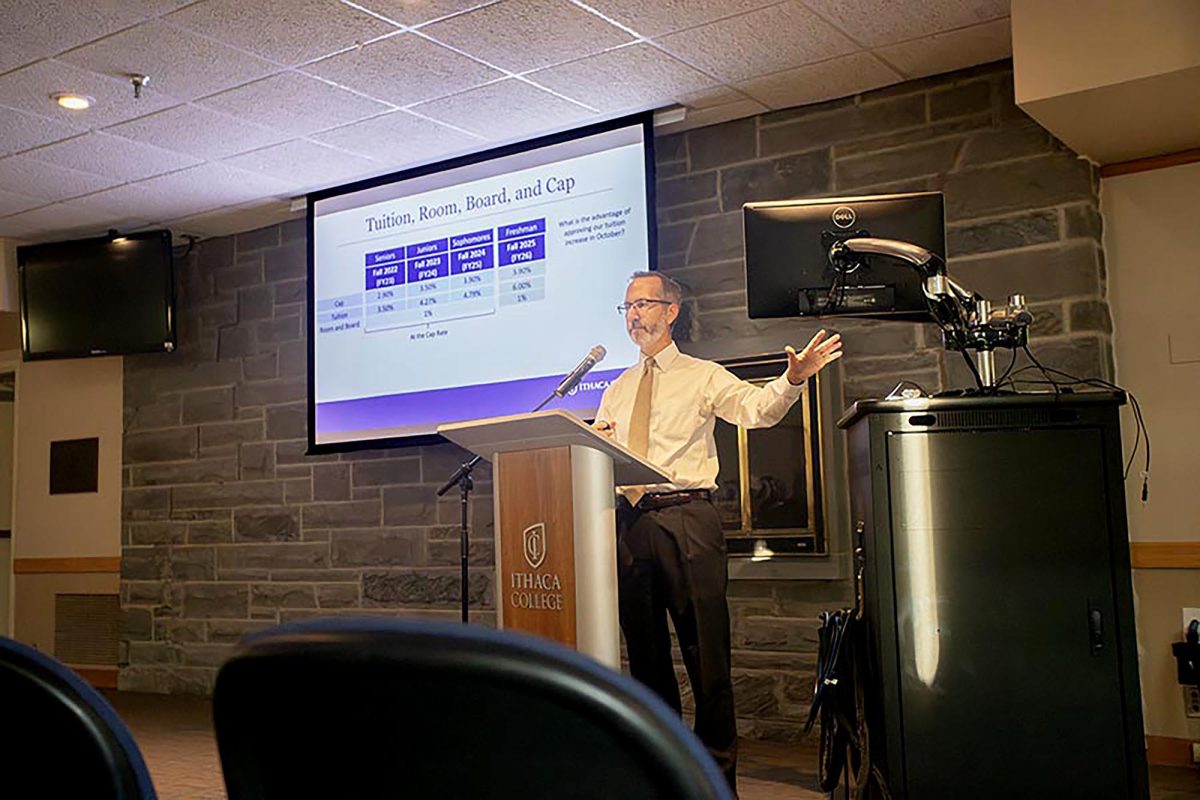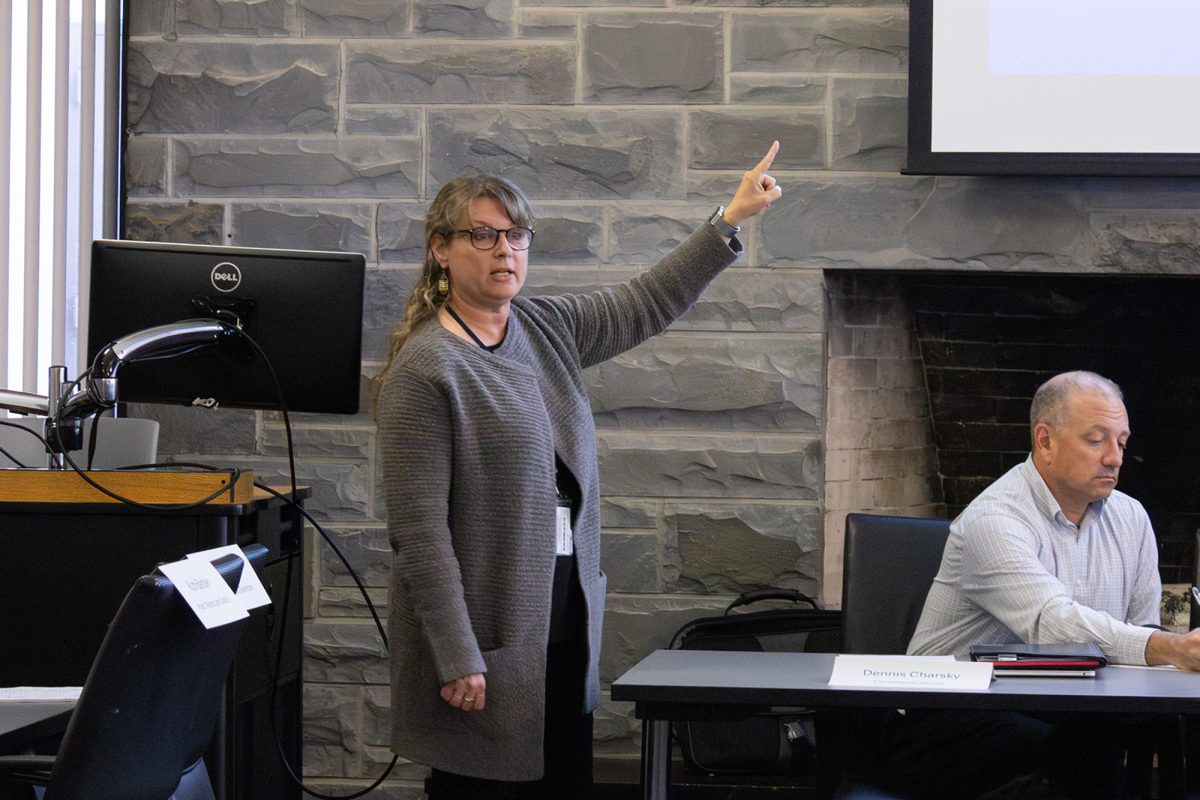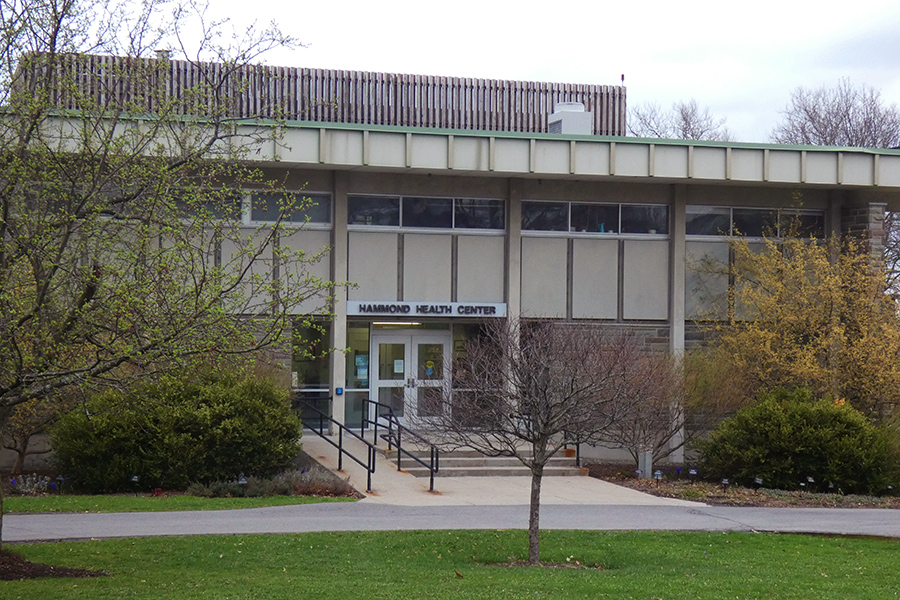The Ithaca College Division of Finance and Administration hosted a Dollars and Sense presentation May 29. The session was open to faculty, staff and students to discuss the college’s performance in fiscal year 2025 and the FY 2026 budget. To continue to combat the college’s financial deficit, the discount rate for first-year students will be dropped from 64% to 60% by FY 2028.
Response to drops in enrollment
Tim Downs, chief financial officer and vice president of Finance and Administration, shared the projected FY 2025 budget summary and compared it to the FY 2025 forecast. The total net revenue was $2.8 million lower than the projected $201.3 million target. Downs said the data presented showed the impact of student enrollment numbers being under the college’s goal because the FAFSA was delayed by about three months in 2024. The low enrollment has caused the college to shift the target enrollment number from around 5,300-5,400 students to 4,500 students.
“What happened was we missed [our goal] by about 182 students,” Downs said. “An 182 miss for that year is a lot. We are still anticipating an $11 million deficit.”
The discount rate on tuition, room and board will shift from 64.5% to 60% for first-year students by FY 2028. The discount rate is the percentage of the cost of attendance that is offset by institutional scholarships and financial aid. According to the current budget model assumptions, the discount rate will be 64.5% in FY 2025-2026 and drop to 62.5% in FY 2026-2027 before dropping to 60%.
“The [Board of Trustees] asked me, ‘What is your biggest concern with your model?’” Downs said. “For me, it’s increasing enrollment while decreasing our discount rate. So we are going to be giving students less money while trying to grow them.”
Downs said each family receives a four year guarantee that shows them how much they will be paying throughout their four years. He said there is a cap on what their cost increases will be which is reassuring to families to know they will not unexpectedly have tuition increase. The four-year guarantee looks different for every student based on their scholarship and financial aid package.
Downs said the college worked with Huron Consulting Group, existing partners and internal teams focused on academics and enrollment to assess spending and potential restructuring throughout the college to help decrease the college’s deficit. Downs also highlighted an increase in collaboration with the Board of Trustees and administration to work to stay on track for breaking even on the operating budget by FY 2028.
The target enrollment for Fall 2025 is 1,150 students and as of May 2025, 1,270 students have enrolled, according to Downs. Downs said that number will decrease when some students transfer or unenroll, but the 1,150 goal will likely be met.
“We are going into this year without an anticipated enrollment gap,” Downs said. “Our team is working hard over the summer to minimize the melt that’s going to occur over the next several weeks.”
Within the detailed look at expenses, Downs pointed out the decrease overall in employee salaries. At the May 20 State of the College meeting, Downs said the college is deferring annual salary increases for FY 2026 to Jan. 1, 2026 as opposed to July 1.
Impact on cash and reserves
Going into FY 2026, Downs said the college is cash positive in its operating budget, but with capital expenditures such as funding the outdoor track and fences around the quads, the total becomes cash negative. This will result in about $40 million dollars in cash being spent over the next three years.
“We want to make sure that during tough times, we use the healthy reserve that we have,” Downs said. “With our friends at [the Division of Advancement], we are trying to work with our alumni and the board … so we can grow capital gifts and grants.”
Restructuring of higher administration
On April 3, President La Jerne Cornish sent an email to the campus community that shared the restructuring of the administration so she will go from having 12 to now five direct reports. Downs responded to a question about how that restructuring will save the college money and said it puts more responsibility under each divisional area to hit its targets.
“[The restructuring] allows divisional areas more flexibility and capacity to make the changes they need to hit the overall budget targets they have,” Downs said.
International student concerns
In response to a question about how a possible decrease in international student enrollment would impact enrollment and the budget, Downs said the college does not have many international students so the financial impact will be minimal if that number decreases. According to the Office of Analytics and Research at the college, as of Fall 2024, 3.3% of the students at IC are international students
“It’s such a small population so it’s not going to be a needle mover for us,” Downs said. “So, it’s likely something we’ll watch, and while it was one of our targeted areas [for growth], these are probably not the years we will be putting money into that to grow it.”
Transfer student incentives
An attendee of the presentation asked Downs how the college plans to increase its transfer population and if there was any additional plan to have a financial incentive provided for them. According to data that Downs presented, there are 78 new transfer students in FY 2025 and the enrollment goal for FY 2026-2028 is 80 transfer students. Downs said transfer students receive financial packages just like any other new student on campus.
“Where I think there is work, and this is something we’re in conversation with enrollment about, is making sure we give [transfer students] things like transfer credits,” Downs said. “Having to retake classes is obviously more costs … so how can we make sure they are not double paying.”















